Forum: Pics - Events, Parties, Other
SAW THIS ON TWO FILE LINKS SITES...........DO U THINK WE SHUD BE WORRIED???
Violated: Rapper From St. Louis Gets Slapped While Freestyling On Camera! (Hops In His Car & Drives Away)
Funniii: Crackhead Gets Slapped Twice For Taking Homeless Man's Money While Sleeping On A NY Train
Smoking Toddler Still Can't Quit: CBS in Indonesia Catches Him Lighting Up His Own Cigarettes & Hanging With Other Adult
B*tchism? Grown Man Snuffs A Woman In The Face! (Leaves Her Crying With A *lo**y Lip)
Bout To Lose Their Job: 2 Jamaican Employees From DC Fighting In McDonalds!



You can call it a flying car or a drivable plane -- either way, the Terrafugia Transition makes good on both travel fronts.
Almost two years ago, we first explored Terrafugia and its Transition in its earlier stages. In development since 2006, the flying car is the finished product of a team of MIT engineers who have labored for years to gain the necessary clearance to operate the Transition on asphalt and in the air. Now, after receiving Federal Aviation Administration approval, the Transition has been cleared to fly our skies.
Classified as a Light Sport Aircraft, Terrafugia needed special FAA accommodation due to the Transition's curb weight. Tipping the scales at 1430 pounds, the Transition is actually 110 pounds over the legal limit for an LSA, but was deemed flight-worthy due to the extra pounds allotted for on-road safety equipment, including airbags and crumple zones. Terrafugia wanted to maintain the Transition's LSA classification so potential pilots would only need 20 hours of flight practice before being granted an air license.
Powering the Transition is a 100-horsepower Rotax 912S engine which helps propel the aircraft to a cruising speed of 115 mph. A 20-gallon fuel tank requires only regular-octane gasoline, not leaded fuel, and Terrafugia says the Transition can achieve 30 mpg out on the open road. Full avionics instrumentation is included along with a parachute.
If you have the hankering for a Transition, the anticipated purchase price is currently $194,000, the same amount reported back in 2008. Interested customers may place a $10,000 deposit with Terrafugia at its Web site.
Dimensions
Wings folded:
6 feet 9 inches tall
6 feet 8 inches wide
18 feet 9 inches long
Flight mode:
6 feet 3 inches tall
27 feet 6 inches wide
19 feet 2 inches long
c**kpit:
51 inches at the shoulder
Source: Terrafugia
Mini Monster: Cummins Packs 18-Cylinder Diesel Into Custom Mini

Want to beat a Porsche 911 in a race with a Mini? Some extra power may help, but this seems a little extreme. Still, in order to draw attention to its display at this year's Goodwood Festival of Speed, the diesel experts at Cummins built a stretched Mini with a giant 78-liter turbo-diesel V-18 planted out back.
The idea was born when a glib bystander took one look at Cummins' massive QSK78 turbo-diesel engine, and said he'd like to put that under the hood of his Mini Cooper.
"We never like to let a challenge go by unanswered," said Cummins spokesman Steve Nendick, "so we got to thinking maybe we could fit the QSK78 into an original Austin Mini. It proved to be a bit tricky to fit under the bonnet but our engineers came up with a more creative solution."
Arguably, the QSK78 itself is as wild as the entire idea. According to Cummins, the engine is a 78-liter, turbo-diesel V-18. We can't emphasize the "turbo" prefix enough -- after all, the engine has no less than 12 turbochargers bolted onto it. The forced induction helps the 11-ton engine pump out 3500 horsepower and over 10,300 pound-feet of torque, which is more than sufficient for its usual role: powering a loaded-down mining dump truck.
It's certainly a cool piece of sculpture, but we'd give Cummins more credit if it were actually crazy enough to try and get this contraption running. Since we can't see a cooling system or any transmission bolted to the QSK's bellhousing, it's a safe bet the mega-Mini will simply remain a static display.
Source: Cummins

Floating Aerohotel by Alexander Asadov is a marvelous architectural design that will be a landmark for the floating structures of the future. Featuring the 200 meters wide central body sitting on various beams, resembling a bicycle wheel with supporting arms, the Aerohotel will enclose cafes, restaurants and winter gardens, alongside the key hotel.
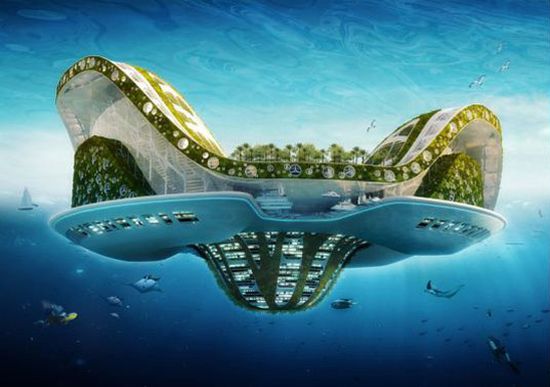
Proposed as a Floating Ecopolis for Climate Refugees, the Lilypad can house about 50,000 inhabitants. The stunning retreat seeks a place for itself in the year 2100 when half the worlds existing shorelines have disappeared due to raising sea level.
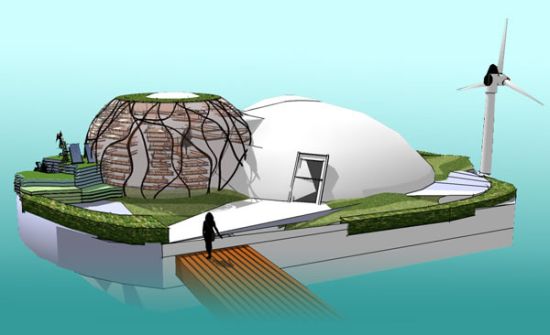
Waterpod floating house is a triple-domed island that will fulfill all its energy requirements from natural sources. Finished with recycled wood, metal, plastic, fabric and other materials, the Waterpod will support alternative energy and vertical agriculture irrigated by the purified water from the Hudson River.
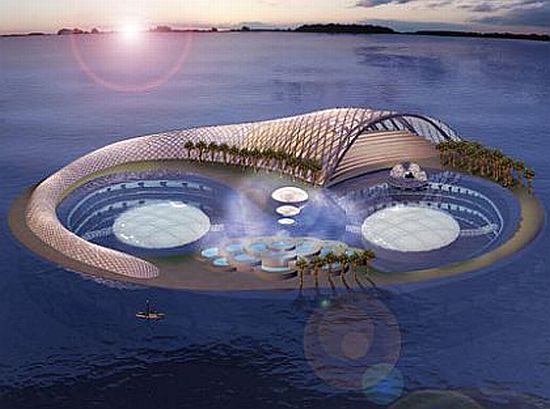
Anywhere but Dubai, the idea of building a luxury hotel 66 feet underwater would sound far-fetched. But next to the Burj-al-arab, the rotating skyscraper, manufactured islands and indoor ski slopes of the desert commerce capital, the Hydropolis will fit right in. At a rough cost of UK£300 million, this jaw-dropping engineering challenge will allow guests to get a true taste for the peace and beauty of underwater life.
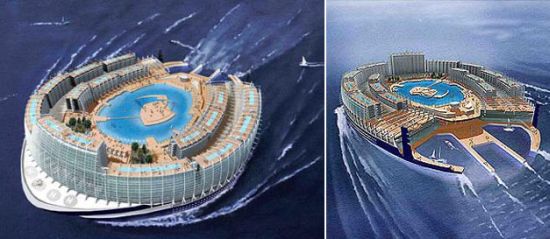
AZ Island is a concept of an artificial island thats capable of movement out at sea. AZ Island is the brainchild of Jean-Philippe Zoppini, who is working in conjunction with the company Alstom Marine to realize his dream. The man-made floating wonder is huge in proportions. If conceived, it will measure 400m X 300m; capable enough to house 10,000 passengers simultaneously on its surface.
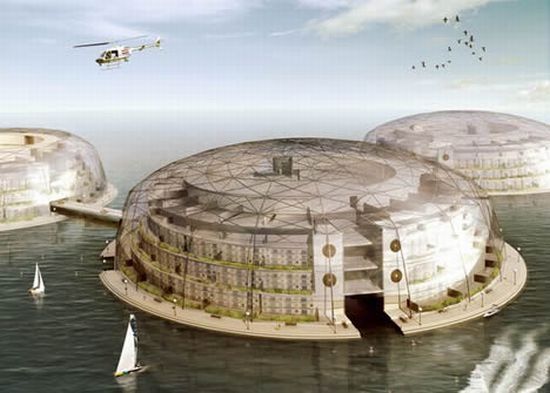
A team of Dutch designers recently revealed a plan to build a floating city on Shanghais Huangpu River. If built, the city will debut during World Expo Shanghai 2010. The floating city will have many green elements it will use the water of the river for cooling and it the city will make use of renewable energy.
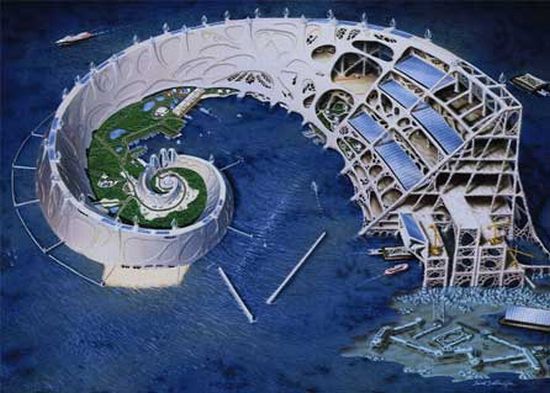
Wolf Hibertz wants to use the oceans as a future site for homes. The visionary designer has found a way to use sunlight to turn minerals in seawater into limestone. The limestone would be used to construct floating island homes. Autopia Ampere would begin as a series of wire-mesh armatures anchored on top a sea mountain. After it is place, they will be connected to a low-voltage direct current supplied by solar panels.
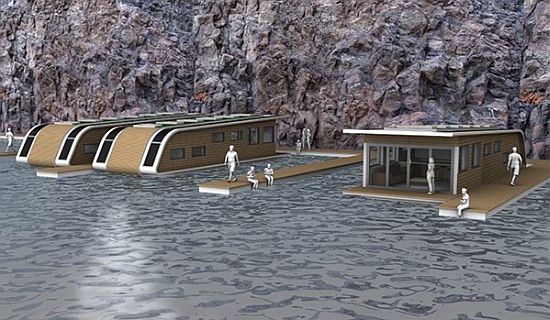
Dubbed the SolarHome, the 75m2 homes wont be as spacious as the home you are currently living in, but will keep you floating on solar-power for a period of six to 12 months, before youll have to come back to shore for supplies. The design feature off-the-grid solar living while floating on water all through the year. The home can be operated in two modes Docked Mode, which requires you to connect to the infrastructure for power and supplies and a Self-Sufficient Mode, which enables you to run off-the-grid for a year.
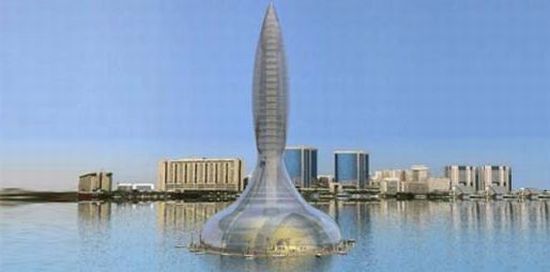
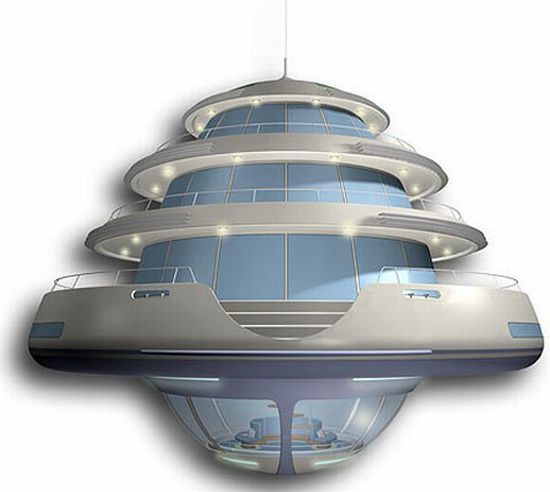
-- Edited by NoKTurnaL on Tuesday 29th of June 2010 11:56:58 PM
NUH UHHHHHHHHH!!! MAN GETS A LITTLE TOO EXCITED AT THE CLUB . . . AND ENDS UP DOING THE UNTHINKABLE TO A WOMAN
NUH UHHHHHHHHH!!! MAN GETS A LITTLE TOO EXCITED AT THE CLUB . . . AND ENDS UP DOING THE UNTHINKABLE TO A WOMAN HE JUST MET ON THE DANCEFLOOR!!!


The Donghai Bridge was the longest cross-sea bridge in the world until Hangzhou Bay Bridge opened on 1 May 2008. It was completed on December 10, 2005. It has a total length of 32.5 kilometres (20.2 miles) and connects mainland Shanghai and the offshore Yangshan deep-water port in China.


The nanpu bridge is the first steel and concrete composite girder cable-stayed bridge built in Shanghai. The total length of the bridge is 8346 meters with a center span of 423 meters, ranking fourth among cable-stayed bridges in the world. the tower height is 150 meters with two lines of strong cables suspending the bridge. the spiral bridge approach in puxi is considered to be a wonder in world bridge construction.


MAFIA7 AS MY FREN MI DECIDE FI HELP U OUT! HERE R SOME LINES TO LOOK GIRLS IN THE CHAT! LMAOOOOOOO












-- Edited by NoKTurnaL on Tuesday 29th of June 2010 10:55:20 PM
NUH UHHHHHHHHH!!! GIRL POSTS PICS ON FACEBOOK . . . OF HER POSING IN FRONT OF HER NASTY AZZ BATHTUB!!!
NUH UHHHHHHHHH!!! GIRL POSTS PICS ON FACEBOOK . . . OF HER POSING IN FRONT OF HER NASTY AZZ BATHTUB!!!
 | |
WORLDS CRAZIEST STATUES (PHOTOS)---------MUST PREE-----WHICH 1 U THINK IS DA CRAZIEST????












-- Edited by KrYsIs on Friday 18th of June 2010 02:35:29 AM
-- Edited by KrYsIs on Friday 18th of June 2010 01:03:05 PM
PROMOTER: DJ Q (from black dynasty group)
ALL THO A GARRISON VYBZ MI SEH WE AFFI SUPORT THE PARTY DEM
1. locate the virtual dj skins folder, normally in C:\Users\_____\Documents\VirtualDJ\Skins.
the skins are packaged in zip folder.
2. extract the zip folder of the skin u wanna edit.
nb/ u will get a bmp file and a xml file, only the bmp file is needed.
3. open the bmp file in the photo editing software and using it as a canvas create your design.
4. after you finish your design, save your art.
nb/ make sure to save it back with the same name as the original
5. compress the edited bmp file with the original xml file in a zip folder and put it back in the vdj skin folder.
THATS IT!!!
my design below as proof.

-- Edited by DJ FiFTY on Friday 25th of June 2010 11:30:35 AM

Your favorite emcee now has a new luxury car to rap about. Mercedes-Benz has just revealed the prototype for their new SLS AMG E-Cell vehicle. The car, which boasts a 526 Horsepower engine, can reportedly go from 0-to-60 mph in a staggering 3.6 seconds. Wow! The SLS AMG E-Cell also comes in an electric model, making it enviromentally friendly as well as extremely good looking. Though it won't be available for purchase until at least 2015, you can check out the photos. This is one whip that we're sure to hear more about in the years to come.




BP OIL SPILL ARTWORK--------(TELL ME WHAT U THINK)--------------------------KrYsIs
- Spoiler
- %$^A UNNUH LOVE SCREENSHOT 2MUCH....GO READ a BOOK....LOVE SUSS 2MUCH







some of those look like they might have hurt
FLIPPA CAN FORGET BOUT DI OL TRUCK AN GET THIS PORSCHE INSTEAD




-- Edited by +0p$h0++@ (Mod) on Wednesday 19th of May 2010 04:08:46 PM
Everybody Loves Dora But which Dora do u like(pic inside) She stop par wid Boots and look wat happend

DORA THA BOY EXPLORER
She stop parr wid boots and look wat happend

-- Edited by Black Flame on Sunday 13th of June 2010 11:00:51 PM
-- Edited by Black Flame on Sunday 13th of June 2010 11:01:32 PM






















-- Edited by dj naz on Sunday 6th of June 2010 01:26:37 PM
LUUUU OF THE WEEK: WHAT JAVON SEH HIM WAAH NICK AND HIM MADDA FI DO???????

Fluffy at dem again.. 4 all a unu nuh waah see Fluffy strive unu go weh..



Two computers, two USB ports, four decks and a range of effects.
Introducing the first professional DJ mixer with two USB 2.0 High Speed ports with support for real-time connection of two computers. Two DJs can work in parallel and/or seamlessly transition from one DJ to another.
Two independent USB 2.0 High Speed ports, each supporting twenty-two, 32-bit floating-point audio channels at 48 kHz.
Real-time support for two computers.
Support for 2, 3 or 4 Virtual Decks on one or two computers.
Direct control of over 30 Scratch Live Library, Cue and Loop functions.
Unique FlexFx bus:
Process a sub-mix of up to six audio channels.
Six internal effects with seamless on-beat switching between effects.
External analog insert support for legacy hardware effects.
USB insert support for computer-based effects.
Four full-featured input channels:
Four stereo Phono/CD inputs of Line, Phono or S/PDIF.
Four stereo auxiliary inputs.
Four stereo USB playback options.
Two mic inputs: one with phantom power and one with line-level.
3-band full-cut EQ, plus new High-pass / Low-pass Filter.
Flexible USB recording options, record from any PGM or output.
Internal universal switching power supply (100-230 VAC)

Front & RearPanels
The FlexFx Mix Level controls the level of the FlexFx signal going to the Main Mix.
The Contour Control for the PGM Faders affects all four channel faders.
The Contour Control for the Crossfader has a separate adjustment.
Both 1/4" and 3.5mm headphone jacks are ready to plug into.
The Fader section is easily removed for cleaning or replacement.

PGM Inputs 1-4
The Sixty-Eight has four stereo analog inputs for PGM 1 through PGM 4. Any of these analog inputs may be set for Phono Input, Line Input or S/PDIF using the P - L - S switches on the rear panel. Any of the four analog inputs may be used for Scratch Live vinyl emulation control. Input 1 or Input 2 may be selected for Scratch Live Virtual Deck 1 control. Input 3 or 4 may be selected for Scratch Live Virtual Deck 2 control. Control input sources are selected in Scratch Live.
Mic Inputs
The Mic Inputs accept an XLR or a balanced or unbalanced 1/4" plug. Mic 1 has a switchable phantom power option, and Mic 2 has a switchable line level option.
Analog Outputs
All analog outputs come from the same Main Mix signal. Main, Booth and Session outputs each have their own Level control. The Main output is on balanced XLR jacks. The Booth output is on balanced 1/4 TRS (tip-ring-sleeve) jacks, though unbalanced TS (tip-sleeve) plugs may be used. The Session output is on regular unbalanced RCA jacks. Because all signals are identical, users may use any of these outputs as the main output if a different cable type is required for connection.
Concept Car Dream Machines - Some Of The Best Concept Cars Of The Past 60 Years
1. B.A.T. 7 (1954)
The second, and most radical, of three Alfa Romeo-based Berlinetta Aerodinamica Tecnica concepts designed at Bertone by Franco Scaglione, B.A.T. was the sensation of the 1954 Turin show. With its semi-enclosed wheels and curling rear fender wings, B.A.T. 7 (center, opposite) looked like a machine from another planet. The B.A.T. cars were proclaimed to be advanced aerodynamic studies, but in truth they were also designed to push Bertone into the top tier of Italian design houses. Which they indisputably did.

2. BUICK LESABRE (1951)
Considered by many to be the greatest concept car of all time, its shape is compelling even today. The LeSabre introduced what has become known as Buick's Sweepspear side trim, a cue still found on current Buick models. The instrumentation would do any aircraft proud, including an altimeter, compass, oil temp and level gauges, a tachometer, conventional speedometer, and others. GM design chief Harley Earl drove it as his everyday car for years. It remains the property of General Motors.

3. LAMBORGHINI MARZAL (1967)
Designed by Marcello Gandini while working for Bertone, the Marzal was a gloriously over-the-top concept from a company that would soon stun the world with the Countach. Built off a stretched Miura chassis and powered by a rear-mounted 2.0-liter straight six that was basically a Miura V-12 cut in half, the Marzal's glass-paneled gullwing doors showcased four silver-clad seats inside.

4. LINCOLN FUTURA (1955)
Clearly a concept from the Rocket Age, the Futura's most outlandish features were all jet-fighter inspired, from its double-bubble canopy to its thrust-forward headlight cowls and huge, rear fender fins. After its tour of duty for Lincoln, the Futura was sold to MGM studios and ended up in the Debbie Reynolds film, "It Started with a Kiss." Ultimately, it found its way into the hands of George Barris to become the original TV-series Batmobile.

5. STING RAY (1959)
GM design chief Bill Mitchell built the Sting Ray as a means of getting around the Big Three racing ban. A Corvette SS tube-frame chassis was clothed in new bodywork designed by Mitchell and young up and comer Larry Shinoda. The Sting Ray raced in 1959 and '60 and then hit the auto-show circuit in 1961. What we didn't know at the time was how closely the car would presage the form and surfacing of the C2 Corvette, still regarded as the most iconic Vette ever.

6. CHRYSLER PORTOFINO (1987)
This Lamborghini-powered concept car was the first to broach the notion of Chrysler's "cab-forward" proportion, which pushed the base of the windshield closer to the front axle centerline, maximizing glass area and interior room. The Portofino's dual scissor doors were a nod to the outrageous Lamborghini Countach. Had the Portofino not been well received, it's doubtful the hot-selling cab-forward LH cars such as the Chrysler LHS and Dodge Intrepid would ever have made it to market.

7. CADILLAC SIXTEEN (2003)
Bob Lutz, GM's vice chairman of product development and chairman of GM North America, called it "a modern interpretation of everything that made Cadillac the standard of the world. He was right: The beautifully detailed, extravagantly proportioned Sixteen was the best-looking Cadillac in decades. But the large and in-charge, 1000-horsepower V-16-powered concept was the right car at the wrong time, too big and expensive to translate to a production vehicle

This was Pontiac's take on the Corvette notion, and not to be outdone by the upcoming Mercedes-Benz 300SL Gullwing, the Bonne-Special's fiberglass bodywork was capped by a canopy, sporting its own flip-up clear panels. It was powered by a Pontiac flathead straight-eight, fed by a squadron of sidedraft carbs. The interior was also aircraft-inspired, and the rear styling gave the impression of a larger afterburner-shaped trunklid.

9. FORD MUSTANG I (1962)
Ford's Roy Lunn and Frank Theyleg had an idea of how Ford could compete with traditional sports car builders such as MG and Alfa Romeo. They put a modern, race-inspired twist on the notion of a compact roadster. The Mustang I concept's engine -- a small, Ford Taunus V-4 of about 109 horsepower -- was mounted in the middle, backed by a four-speed manual transaxle. The production model that ultimately wore the Mustang badge was obviously a horse of another color.

10. CHRYSLER NORSEMAN (1956)
The Norseman never made its debut at an auto show. It was aboard the SS Andrea Doria, en route to New York from Italy (where it was constructed by Ghia) when the Doria collided with the MS Stockholm and sank, taking the Norseman, and 46 lives with it, to the bottom of the Atlantic not far off the coast of Massachusetts. The car was intended to be among Chrysler's concept car displays during the 1957 auto show season. It was never seen by the public, nor by most of the designers who worked on it.

11. CADILLAC CYCLONE (1959)
As with any other '59 Caddy, the Cyclone had over-the-top rear fins and rocketlike taillights. The fighter jet canopy was also in place, and the two doors slid rearward to open. The black twin nose cones resemble missiles, cued up and ready to fire (the headlights were mounted in the grille). A two-way communications system allowed occupants of the car to converse with people standing outside the car without the need for retracting the canopy. The Cyclone's exhausts exited ahead of the front wheels.

12. DODGE FIREARROW I (1953)
One of the best examples of the Idea Cars collaboration between Chrysler and Italy's Ghia, the Firearrow was a daring and elegant expression of an American two-seat luxury roadster concept that Dodge might use to battle the Corvette and upcoming Ford Thunderbird. Firearrow I was originally built as a nonrunning body mockup on a '54 Dodge Chassis; a powertrain was later added to make it a running car.

13. ALFA ROMEO BRERA (2002)
The Brera was proof positive that Giorgetto Giugiaro still "had it," as it had been some time since the founder of ItalDesign, and the creator of so many landmark automobiles, had designed something new from scratch, working almost entirely on his own. The concept was a rear-drive coupe powered by a Maserati V-8, and although the Brera was ultimately developed as a production model by Alfa Romeo, it morphed into a front-driver in the process, losing some-but not much-of the original's flair.

14. GM FIREBIRD III (1959)
The last of GM's turbine-powered Firebird concepts, Firebird III remains one of the most extravagant and technically advanced concept cars ever built. The jet-fighter-inspired bodywork sprouted wings and fins galore, and was made from titanium. The car also featured fully functional joystick control for steering, braking, and acceleration, a stunning achievement in an age before microprocessor-powered computers.

15. FERRARI MODULO (1970)
Designed at Pininfarina by Paolo Martin for the 1970 Geneva show, the Ferrari Modulo stood just 36.8 inches tall, making it one of the lowest concepts ever. "Is it still an automobile or is it the module of a spaceship of "2001: A Space Odyssey?" asked Lorenzo Ramaciotti, later head of Pininfarina design. He has a point. The Modulo was built on a Ferrari 512 race car chassis, but, despite its midship-mounted 550-horsepower V-12, is not a driver.

16. VW CONCEPT 1 (1994)
VW Audi Group designers J Mays' and Freeman Thomas' crisp, clean interpretation of the iconic Beetle shape featured a transverse-mounted front engine and front drive. Most people assumed this star of the 1994 Detroit show was based on Golf hardware. But it wasn't. It took four years for the Golf-based production version, New Beetle, to appear. It singlehandedly inspired a swarm of retro cars, including the New Mini, the 2005 Mustang, the Fiat 500, and the Dodge Challenger.

17. FORD GT90 (1995)
Per some former Ford insiders, New Edge was a term coined by Ford P.R. looking for a media-friendly hook to describe the GT90's sharply defined surfaces. It became the mantra of Jack Telnak's final years as head of Ford design, influencing cars like the 1999 Cougar, the 1998 Focus, and the 1998 Falcon. The GT90 was powered by a handbuilt 720-horse, 6.0-liter, quad-turbo V-12, created by lopping a pair of cylinders off two modular V-8s and welding the block together.

18. AERO-VETTE (1977)
Of all the many "what-might-have-beens" in Corvette history, the Aero-vette is perhaps one of the best. Mid-engine, with unique bi-fold gullwing doors, the Aero-vette looked truly exotic. GM design boss Bill Mitchell actually managed to get the car approved for production by specifying a small-block V-8 and low-cost suspension to help keep a lid on the price, but the project was canceled shortly after Mitchell's retirement.

ALL THE FOOD DEM PON THE TREE IN TIVOLI A SNIPER .DWWWWWLLLLL

-- Edited by hyperactive sound on Wednesday 26th of May 2010 04:31:10 PM
-- Edited by hyperactive sound on Wednesday 26th of May 2010 04:34:42 PM


























































































